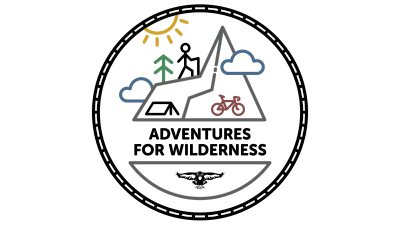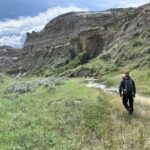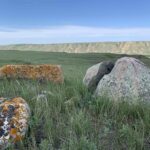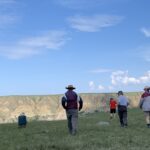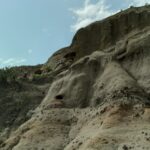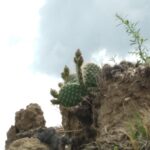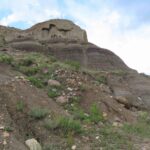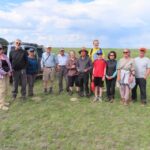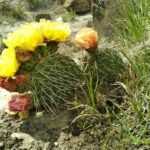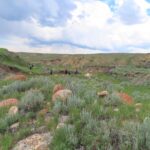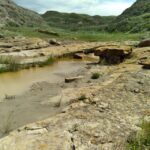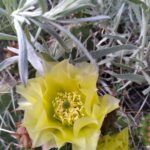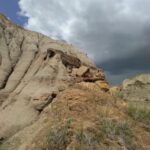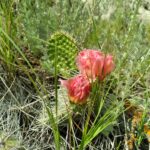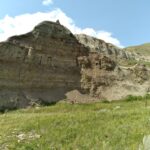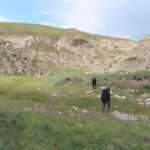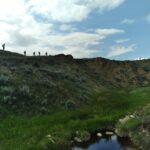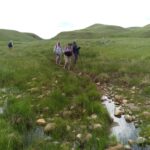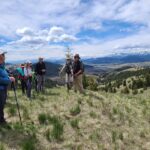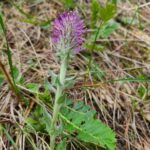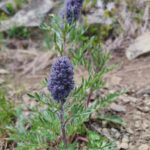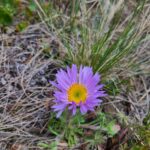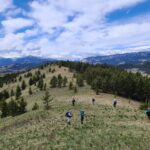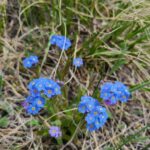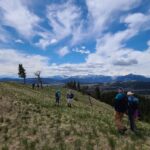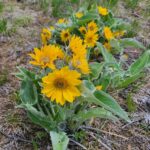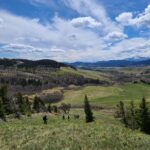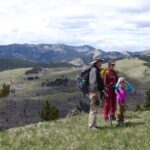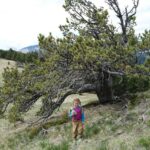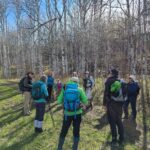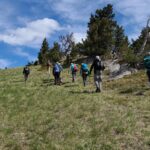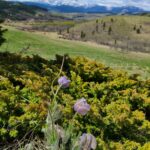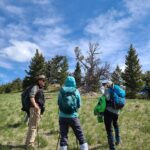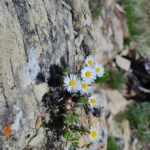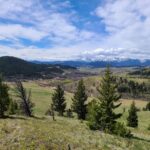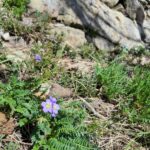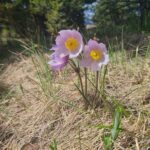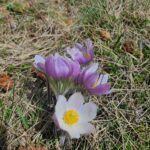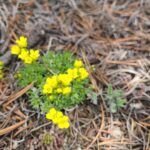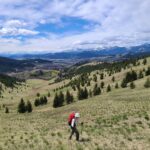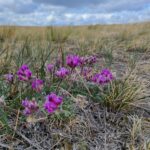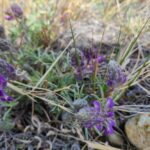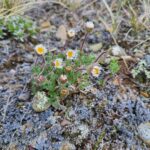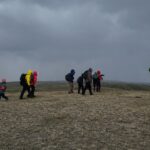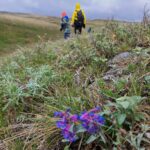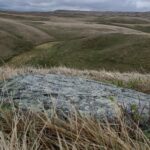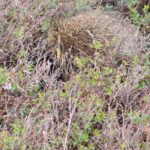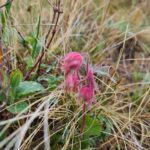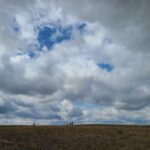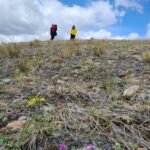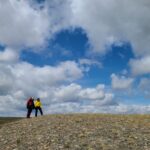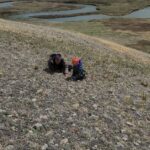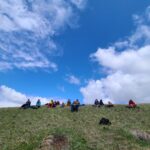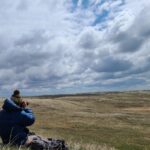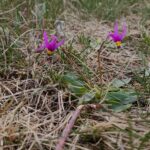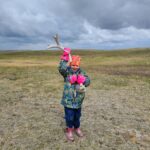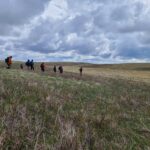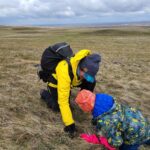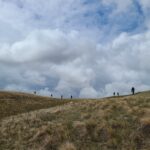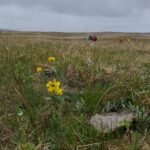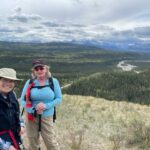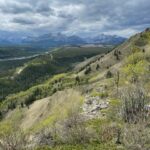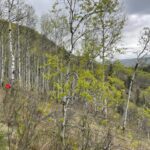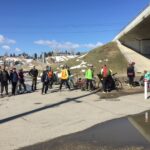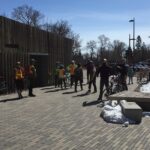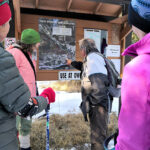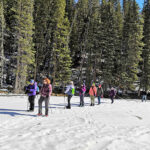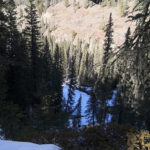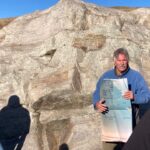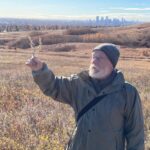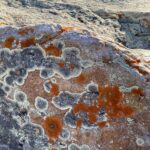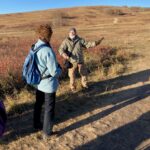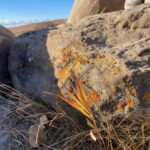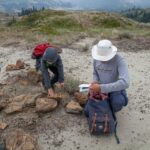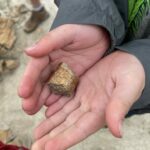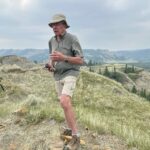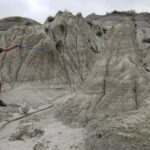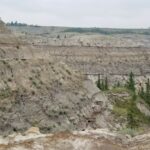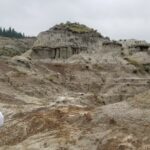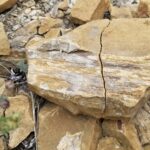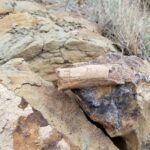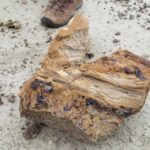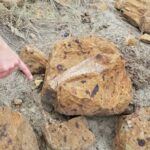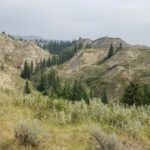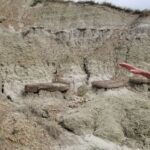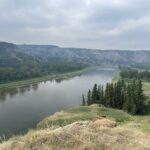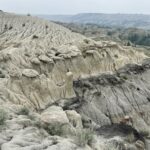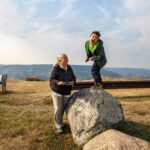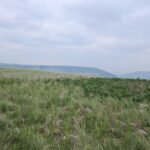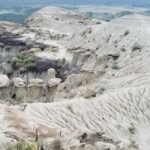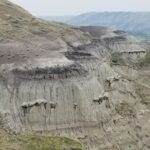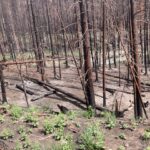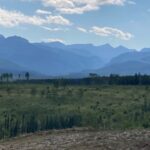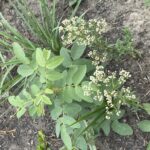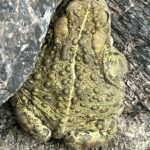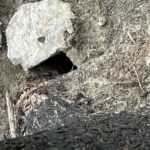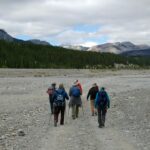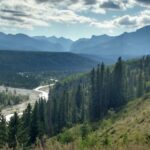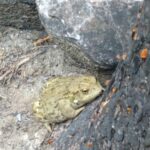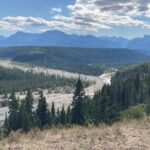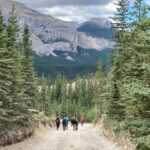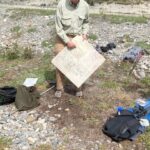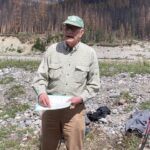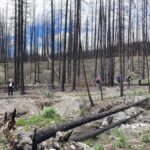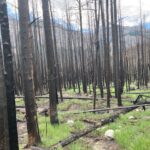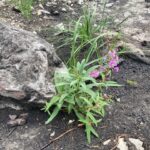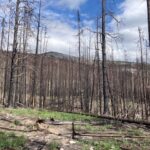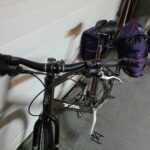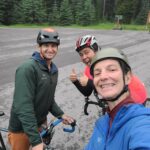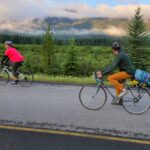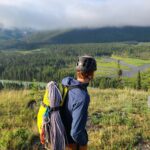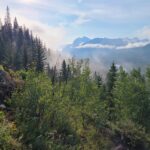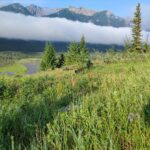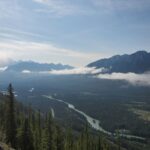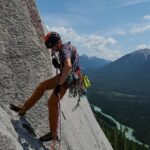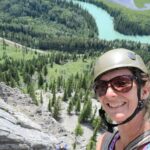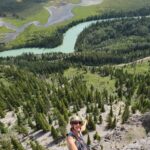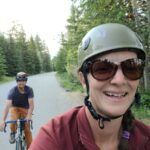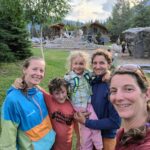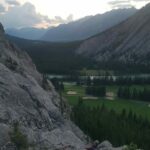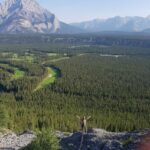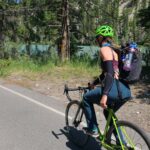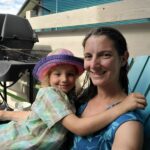One of Alberta’s Rare Landscapes: Hiking White Rock Coulee to the South Saskatchewan River
Written on July 1, 2022, by Sean Nichols
On June 25, a dozen intrepid adventurers met up with Heinz and Kris Unger in Alberta’s southeastern corner for a special treat: the opportunity to hike the coulees along the South Saskatchewan River just across the river from the Suffield National Wildlife Area. This area offers up a true treasure trove of unique landscapes, plant and wildlife, making for a special viewing experience. Despite this year’s rain-soaked ground providing a bit of a challenge, the hikers got an adventure to savour, as recounted by participant Chris Saunders:
The group of 13 met in a remote part of SE Alberta, the junction of Highway 41 and Township Road 174. The first step was to drive west along Township Road 174 to a point which overlooked the canyon containing the South Saskatchewan River. The road was primitive and conditions were wet so after taking in the spectacular views the group drove further south to the head of a valley which would join White Rock Coulee in due course and the coulee would lead to the South Saskatchewan River. The wet conditions caused a small change from the original plan. The valley chosen to enter the coulee was considerably higher up the coulee so the walk down to the river was longer than originally planned.
This is a very rarely visited area, there is no trail either in the initial valley or in the coulee. In addition, the route was unusually wet due to recent rains so progress was slower than anticipated. However, the scenery was magnificent both in the valley and the coulee.
During the initial couple of kilometers, the valley sides were grassy and at a gentle angle. There was real beauty in this undisturbed grassland. The cacti and wildflowers were in full bloom and we had an expert in the group who helped to identify the less common prairie plants. After the valley joined the coulee, the gradient down towards the river steepened and the sides of the canyon became steeper, turning into bona fide cliffs in the later stages. The group continued down the ever deepening coulee until the turnaround time of 3 o’clock but unfortunately still did not reach the river. The additional distance and the wet conditions meant there was insufficient time to reach the destination.
It was a fine hike in an area new to most of the group. Many are keen to return to the area in the fall to try again.
(below photos by Heinz Unger, Chris Saunders and AWA member Lynn Bowers)
The Grateful Memory of a Rare Alberta Conservation Victory: Unicorn Hunt in the Whaleback with Kevin Van Tighem
Written on June 13, 2022, by Sean Nichols
Renowned Alberta naturalist and author Kevin Van Tighem was gracious to lend us his expertise on a hike through one of AWA’s favourite wild spaces: the Whaleback Ridge. Recalling the history of how this wilderness area was famously saved from development, he relates how the day’s Adventure went:
Eleven hikers joined trip leader Kevin Van Tighem, AWA adventures coordinator Lindsey Wallis and a happy six-year-old unofficial nature guide to explore part of the Bob Creek Wildland on May 28. This year’s slow spring made for easy walking as the trails were dry and, once we headed off-trail, the grass had only just begun to thicken. Evidence of wildlife was everywhere but we had to make do with a single sighting of some white-tailed deer as we headed up a creek and then began the long climb to the top of a foothills ridge. There were plenty of early flowers to distract us from the long uphill slog: balsamroot, alpine forget-me-not, shooting star, buffalo bean, cinquefoil, yellow and blue violets, kitten tail and many others.
Up top the group enjoyed a panoramic view from the Livingstone Range, Oldman River Gap and Bob Creek valleys east to the long forested swell of the Whaleback Ridge. It was a rare wind-free day: an added gift. The lunch stop was not far from an isolated hayfield in the valley below that almost became the site of an Amoco gas well back in the early 1990s. Had that well been drilled and proved productive, it likely would have triggered the development of roads, pipelines and other well sites all through that landscape but — thanks to the determined and principled efforts of groups like the Alberta Wilderness Association, Nature Conservancy of Canada and Canadian Parks and Wilderness Association, working in collaboration with area ranchers and long-time recreational users of the area — that threat was averted when Amoco surrendered its lease and the whole area was protected under Wildland Park and Heritage Rangeland status. As a result, we enjoyed two rarities as we ate our sandwiches among the wildflowers: an entire foothills landscape devoid of roads, and the grateful memory of a rare Alberta conservation victory.
The return trip was along a ridge crowned with wind-gnarled limber pines and Douglas fir trees, surrounded with the green spikes of newly-sprouted rough fescue and the intense colours of tiny wildflowers. We ended the hike as we had begun it, with a wobbly crossing of an un-bridged creek which most boots survived. Back at the cars the last flycatchers were still calling. It was a fine day with a fine group of people.
A glorious day in an ever-diminishing special ecosystem: Hiking the Milk River Ridge
Written on June 3, 2022, by Sean Nichols
AWA has had a long involvement with Southern Alberta’s Milk River Ridge, not least through board member Cliff Wallis’ membership on the Milk River Management Society. So it is always a memorable day when he is able to take us on a tour of this amazing ecosystem. On May 20 he was joined by Cheryl Bradley, another Alberta naturalist with many years of expertise in this grasslands area, as they graciously contributed their expertise to make our “Botany, Birding, and More” exploration of the Milk River Ridge a very special adventure indeed. Chris Saunders and Lindsey Wallis took photos and jointly wrote this story from the field trip.
When most of the group left the meeting place in Lethbridge in a severe storm featuring lashing rain and very strong winds, few thought this hike would go ahead. However, Cliff, our self-proclaimed “Sunshine Superman,” assured everyone the weather would change for the better. As the group drove south along Highway 4 the rain continued but after turning west and south on gravel roads it stopped.
Fourteen hikers and a stuffed wolf carried by our youngest naturalist set off to the south-southwest up the ridge from a point about four kilometres from the Taylor ranch house. This is in the eastern portion of the Milk River Ridge. There was no rain but a fierce wind was blowing from the north, making the right clothing essential. It has been a very dry spring in the area and the grassland plants were just beginning their spring growth. Along with the hike leaders Cheryl and Cliff, there were a number of other experienced naturalists in the group. As a result, there were plenty of sightings of plants and wildlife together with extensive discussion. One highlight was an “up close” view of a large porcupine seeking shelter from the wind in a clump of low bushes. A herd of deer were also spotted on a far ridge, silhouetted against the sky.
Lunch was held at an impressive viewpoint at the top of the Ridge, where the snow-covered Sweetgrass Hills in Montana could be seen clearly to the south east. After lunch, on the descent, there was a brief squall of ice pellets driven by a strong wind that drove the hikers back to the trailhead like horses to the barn. Amazingly, this was the only precipitation the group experienced during the hike.
On arriving back to the vehicles, an intrepid few drove further west to the Sandstone Ranch to search for the fuzzy-leaved purple jewels that are the rare hare-footed locoweed. The group combed gravelly slopes above the sinuous river valley and one appeared… and another… and another! A good colony of these threatened plants were found, as well as larkspur, flax and other hardy natives. With the sky clearing, a prairie falcon was seen making trips back and forth to what may have been a nest on the other side of a sandstone outcrop. The same cliffs held two other apparently disused raptor nests, as well as a colony of cliff swallows.
A glorious day in an ever-diminishing ecosystem that is so special in both the micro and macro views.
Finding Spring Wildflowers on the Ghost’s Lesueur Ridge
Written on June 1, 2022, by Sean Nichols
Hike leader and longtime AWA friend (and past board member) Heinz Unger has lived in the Ghost/Waiparous area for many years, so he knows the Ghost watershed like the back of his hand. Who better, then, to lead a cool spring hike up the area’s Lesueur Ridge?
Despite the poor weather forecast for Sunday May 29, five intrepid hikers turned out for the loop hike up Lesueur Ridge. Although spring is coming late this year, the aspens were just leafing out in the brightest possible green, and the fescue meadows were greening up, too. There were still lots of prairie crocus in the shade and many bright Goldenbeans. Lots of short-stemmed shooting stars grew in abundance and we also saw some small mountain avens and a few yellow locoweeds.
The trail was steep but easy to walk because it was so dry. The hike down to the valley trail was equally steep, then followed by an easy walk through mixed woods and past gnarly old Douglas firs. And the views from the top were great, with lots of snow still on the mountains to the south and west, and dark rain clouds in the north. But the weather was actually quite nice, even a bit sunny, and only for the final 15 minutes there was a light drizzle to see the group back to the trailhead.
A Return to Our Roots: Climbing Stairs on Earth Day
Written on May 21, 2022, by Sean Nichols
For over 25 years, AWA’s signature Earth Day event was the Climb for Wilderness, when Calgarians would gather to climb stairs and raise money for Alberta’s Wilderness. This year we were excited to return to those roots with a “Climb Stairs and Cycle on Earth Day” Adventure! AWA board member Chris Saunders set to the task of creating and coordinating this adventure and talks about how it went. Thanks to participant Laszlo Jamniczky for the photos!
On Saturday April 23rd 2022, the nearest Saturday to Earth Day, 18 participants set out to test their endurance skills against a course of outdoor staircases, with a series of short cycle rides in between. The age of the participants covered a broad range, from 3 years old to late seventies. The bikes used by the participants had a similar range from sleek lightweight racers to steady roadsters. Most of the participants arrived at the starting place on their bikes.
The course started at the Ukrainian Catholic church in Renfrew where there was a very large staircase to be ascended and climbed to kick things off. Group then cycled east along footpaths and quiet roads to do several more staircases in Renfrew. After that the route went south along the Nose Creek pathway and onto St Patrick’s Island where some unusual steps were climbed and descended at the “mound”. After the staircase at the Bridgeland LRT station the route took the group to couple of staircases in the south western part of Bridgeland. Then a lengthy cycle west along the Bow River pathway brought the group to the large staircase at the Calgary Curling Club. The group tackled the staircase successfully and then cycled up the path to the top of the bluff. Some tiredness was setting in at this point but most of the group continued on by cycling east across Centre Street to a staircase in Rotary Park. The final stretch was further east and involved a series of four staircases in Regal Heights each of which drop down to land near Edmonton Trail. Having completed that test, all that was left was a simple ride back to the Ukrainian church in Renfrew.
Throughout the course the event coordinator spoke to the group about AWA’s work and some of the challenges facing Alberta’s wilderness.The event was a success in that all participants enjoyed the event and a significant amount of money was raised for Alberta Wilderness Association through sponsorships and donations. The coordinator is considering holding a similar event next year in a different part of the city. Watch out for the posting in early 2023.
Winter Hike on Waiparous Creek
Written on March 15, 2022, by Kevin Brennan
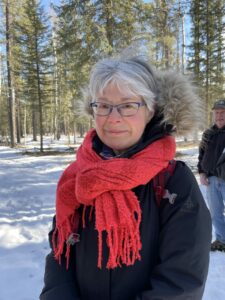 By – Peta Stuart
By – Peta Stuart
It’s your AWA trusty reporter, checking in after a great Alberta Wilderness Association Adventure along Waiparous Creek led by Mr Heinz Unger.
Our drive west toward this area afforded snow-capped Rocky mountain views; of particular note, the curiously-shaped Devil’s Head mountain. We had a sighting of bald eagles (Haliaeetus leucocephalus) and passed the Jumping Pound plant flares tickling the sky.
Our destination, Waiparous Creek, is steeped in history. The First Nations considered this place an important winter hunting ground. According to the book Place Names of Alberta, the name Waiparous is a corruption of the Stoney Indian name meaning “Crow (Indian) scalp” (Karamitsanis 1992). The Simpson and Palliser Expeditions of 1841 and 1858 both mention the confluence of the Waiparous Creek and the Ghost River.
The Eau Claire (there is a Waiparous trail with this moniker) Lumber Company harvested lumber in this area in the 1920’s. Logs were flushed down the Waiparous Creek and Ghost River. Remains of the temporary log dams can be observed along Waiparous Creek.
Our hardy group of hikers donned ice cleats and filed behind Heinz along the (mostly) frozen river. Beautiful sandstone walls line the creek. The river ice sparkled under bluebird skies. On the way to see the confluence of Waiparous Creek and the Ghost River, we identified cougar (Felis concolor) prints in the snow. We also noted a stonefly adult (Plectoptera) wiggling across the snow in search of a mate. These ancient insects have been around for 300 million years.
The Waiparous Creek area is in the montane zone. The forest is mixed conifer – in particular white spruce (Picea glauca) – and a smattering of deciduous trees. We noted at least two kinds of juniper peeping from the snow; the prickly common juniper (Juniperus communis) and the creeping juniper (Juniperus horizontalis).
The moist banks of Waiparous Creek are a perfect home for the evergreen Stairstep moss (Hylocomnium splendens). Each branch along this feather moss main stem represents a year’s growth. We also noted the delicate dwarf scouring rush (Equisetum scirpoides) that grows alongside a natural spring; at first it looked like a patch of grass. We had good discussions comparing the Waiparous natural forest to a large tract of unfortunate Fire Smart forest that stretches far from human habitation.
Thank you to Kris for bringing up the rear! The Unger family treated us to a delightful end-of-adventure with mulled cider and sweets, overlooking a panorama of the Waiparous to the Rockies, and cohosted by a pair of ravens (Corvus corax). Keep this natural area safe!
Reference: Ghost River State of the Watershed Report, 2018
Recapturing the Feel of the Native Prairie: A Fall Ramble on Nose Hill
Written on February 13, 2022, by Sean Nichols
One of Canada’s — and indeed North America’s — largest urban parks, Calgary’s Nose Hill is an incredible treasure that we are lucky to have. AWA member Wendell Koning went along on our Fall Ramble on Nose Hill Adventure in October 2021 and expresses his appreciation:
On the morning of October 21st, about 15-20 of us gathered in the early morning sun, to learn more about the botany and geology of Nose Hill Park. The park is found in the northwest part of the city covering 11 sq km. From the top of the hill, on the plateau, one can get awesome views of the downtown to the south; the airport (airplanes coming and going) to the east; and the Rocky Mountains to the west. And in some parts of the park, namely in the many valleys, you can feel what it was like 200 years ago, to be all alone on a native prairie!
Christyann Olson, recently retired Executive Director of AWA, gave a brief overview about the AWA and the history of the park. We had two specialists for this tour, Karel Bergmann, a very experienced botanist, with a wealth of local and international knowledge, and senior geologist Tako Koning, who is passionate about all things geology.
The two specialists worked in tandem – Karel would show us various plant species and how they are adapted to their specific environments, and then we’d stop at rocky outcrops including some massive rocks known as glacial erratics, to learn more about glaciations, rock striations, and the various fossils that could be found (sorry, no dinosaur fossils at Nose Hill, but plenty of other types!).
And at the same rocks or nearby rocks, Karel, an expert on lichens, pointed out the myriad of lichen communities attached to the rocks. Lichens are a life form that we often pass by without noting, even though some display an incredible mix of colours.
The tour ended too soon but I’m sure all participants would agree that we gained new, very entertaining, and super-informative perspectives on this beautiful and pristine urban park.
Thanks to Karel and Tako, and thanks to Christyann Olson and the AWA for organizing!
Alberta’s Unique Paleoecological History: Dinosaurs and Badlands
Written on October 22, 2021, by Sean Nichols
For the second year, AWA was thrilled to be able to offer a special treat: an exclusive audience with Dr. François Therrien, Curator of Dinosaur Palaeoecology at the Royal Tyrrell Museum; followed by a hike to explore the bonebeds at Dry Island Buffalo Jump Provincial Park. This year’s outing on July 16 and 17 was coordinated as a joint endeavour by Christyann Olson; along with Rob and Tjarda Barratt, who recount:
Dinosaurs and Badlands (take 2!), was another very informative and enjoyable Dinosaurs and Badlands Adventure this year that we coordinated with Christyann Olson. On the evening of July 16th Dr. François Therrien, Curator of Dinosaur Palaeoecology at the Royal Tyrrell Museum, delivered an excellent presentation via Zoom on Alberta’s wealth of dinosaur fossils with emphasis on the Albertosaurus bonebed in Dry Island Buffalo Jump Provincial Park. The next day Rob led us on a hike to the bonebed.
François Therrien’s presentation: “Albertosaurus Bonebed in Dry Island Buffalo Jump Provincial Park”
François’ presentation on the abundance and diversity of dinosaur fossils found in Alberta was captivating. Alberta is among the top five places in the world for dinosaur fossils. François explained that a combination of two conditions are required for dinosaur fossils to be found: first, rocks must be of the right type and age that formed when dinosaurs were alive, and second, these rocks must be exposed at the surface. Alberta has the perfect combination of both, and that is why it is so rich in dinosaur fossils. François described the many important dinosaur discoveries made in Alberta over the past 120 years, with emphasis on the Albertosaurus bonebed originally discovered in 1910. The full significance of the discovery only came to light after Dr. Philip Currie, then of the Royal Tyrrell Museum, resumed excavations in 1997. The diorama at the entrance of the Royal Tyrrell Museum is based on the fossil record from the Albertosaurus bonebed.
Hike in Dry Island Buffalo Jump Provincial Park
Under cloudy and smoky skies, we met at the upper viewpoint of Dry Island Buffalo Jump Park with its glorious views down the Red Deer River valley. Christyann, Rob and Tjarda explained the significance of the park and need for conservation of its fragile lands, it’s diversity of plants, birdlife, butterflies, native treasures and paleontological sites.
As we walked and scrambled down fascinating badlands, crossing millions of years of geological history, we tried to imagine the lush subtropical forests and flood plains that existed during the age of dinosaurs 70 million years ago. At the bonebed, where we stopped for lunch, we posed for a photograph at the exact location of a photo taken 111 years ago by Barnum Brown’s expedition in 1910. It was with the aid of this old photo that Dr. Philip Currie located the original quarry in 1996. While most of the fossils have now been excavated and removed, there are still scattered fossilized bone and wood fragments to make a visit to this site well worthwhile.
We ended the hike with a scramble through dense bush. Then we refreshed ourselves with sweet juicy watermelon at the picnic site near the river’s edge and took time to look at old photos while talking about the day’s Adventure. We made some great new friends that day and the success of the day’s hike was evident in all the happy faces!
Effects of a 2020 Forest Fire, One Year Later: Ghost Wildfire Exploration
Written on October 13, 2021, by Sean Nichols
Wendell Koning is a Limnologist / Water Quality Specialist, recently retired after 20 years with Alberta Environment and Parks. He thus provides a unique insight as he discusses his experience on the August 11 “Ghost Wildfire Exploration” Adventure coordinated by Heinz Unger:
In August 2020 there was a small forest fire of about 200 ha that burned in the upper Ghost River watershed. Then in September-October 2020 there was a much larger fire in the watershed that consumed 3500 ha. Many of the inhabitants in the watershed were put on high alert for potential evacuation. In the end evacuation was not required, but the fire was extensive. So, it was with much interest and anticipation that 8-10 of us signed up to be part of this AWA tour led by local inhabitant, and (uber fantastic) AWA volunteer, Heinz Unger and son, Kris.
We met on the morning of Aug 11, 2021, off Highway 40 where it intersects with the Transalta Road (this was located about 30 km northwest of the turn off onto Highway 40 from Highway 1A, i.e., northwest of Waiparous). We then carpooling to complete an additional 16 km on the gravel Transalta Road. We parked in the Ghost valley and then walked along the valley bottom (flood plain) of the North Ghost River to the Black Rock Mountain trailhead area which was burned, and there we explored the area in detail.
Our specialist on the tour was Professor Edward A. Johnstone of the UofC Biosciences Department; his area of research is primarily in the contact between the geosciences and ecology. Professor Johnson had us spell-bound several times when we stopped for site-specific observations coupled with much fire theory, fire behavior modelling, and meteorological science of fires. The trip lasted MUCH longer than was estimated for the tour, as the discussions continued and continued, they were delightful!
It was very interesting to see how after just one growing season, much greenery was coming back. We walked through heavily burned areas and, in some places, just meters away, the land was untouched by the fire, perhaps due to specific slope or aspect, or wind variations at the time.
Fires are a natural part of our forest ecosystems, they result in the beneficial release of nutrients, and opening of the forest canopy for new growth, – and therefore can result in a greater biodiversity within a given area. Forest fires occur from two sources, 1) – natural sources, namely from lightning strikes; and 2, from human activity, either intentional (arson), or more often, unintentional, for example, campfires not fully extinguished; from tossed cigarette butts; or from sparks and heat from the hot exhaust pipes of motor vehicles.
Currently, are we experiencing more forest fires now? Yes, a) climate change is real and having an affect (more heat, more extended periods of high-pressure systems), and b) as per earlier, there are more people living, working and recreating in the forest areas resulting in more human-caused forest fires.
Are forest fires hotter today than in the past? We hear that fire suppression for the past 100 years (our current form of forest management) has resulted in buildup of more brush, more fuel for fires? Apparently, not, since along with the additional growth (fuel buildup) in the forest understory due to longer periods between fires, there would be additional death and decomposition. However, the Alberta “Fire-Smart” program which includes promotion of removal of brush etc. from wooded areas inhabited by humans – is excellent, effective, and very appropriate for those who have cabins and houses in the woods, in rural or wilderness areas. See: https://wildfire.alberta.ca/firesmart/default.aspx
The tour was 100% first class, I’m sure I speak for all the attendees, we learned a ton – and it was fun! Kudos to the AWA for highlighting this issue via the Ghost Watershed Tour.
An Amazing Adventure for a 40th Birthday! “40/40/40”
Written on October 13, 2021, by Sean Nichols
Lindsey Wallis chose a truly unique way to celebrate her 40th birthday: “Forty kilometres by bike. Forty pitches of climbing. All in forty hours.” Read on to hear how it went!
Thanks to everyone’s donations my 40/40/40 adventure has raised $5,701 for the Alberta Wilderness Association in support of their conservation work here in Alberta.
The actual adventure was spectacular, I couldn’t have asked for better weather, or a better team to help me succeed. Big thanks go to Keith Brodsky and Leslie Gerin, who provided a home base for my support team and outfitted me with some of the last minute things I needed. Also, Sarah Elmeligi, Shy Weeks and Kyle Eustace who joined me for different legs of the adventure and kept the stoke high and making me laugh, even when I was sooooo tired.
In the end I cycled 44 km and climbed 42 pitches of 5th class in 36 hours. I even got 4-5 hours of “sleep”! We started from Castle Junction at 6:30am, and biked along the 1A to Guide’s rock, where Kyle and I climbed 18 pitches on three different routes. Then we returned to our bikes (and the horrendous mosquitoes) and continued biking along the Vermillion Lakes road to the town of Banff where I stopped about 7 pm for a mandatory refuel (beer and chocolate croissants from Shy) in the park by the river before Shy tagged in and we biked to Rundle and climbed 6 more pitches on the route Sunriser at sunset. By the time we rappelled back down it was dark and we hiked down to our bikes by headlamp where we made a quick dinner and crawled into our sleeping bags about 1 am. The next morning the sun (and mosquitoes) woke us up early and after a much needed coffee were on our bikes for a short ride along the golf course in Banff to the next climb. After not enough sleep (I need my 8 hours!) the approach hike felt extra steep and the seeping wet rock extra slippery. I’ll admit that I didn’t have too much fun on this climb. But the day still had one more climb in it, as we cycled around the golf course loop and back to where we bivied and climbed the last 9 pitches of the day and the adventure. The sun was scorching hot but the rock quality was amazing and the climbing and views spectacular. The rappels felt extra long as we got closer and closer to that long awaited victory beer! Down and back at our bikes the mosquitoes were once again horrendous as we packed our bikes for the last time and rode the few remaining kilometres back to Banff, taking a much deserved dunk in the river on the way there.
Thanks again to everyone for your support. You really make a girl feel special!
